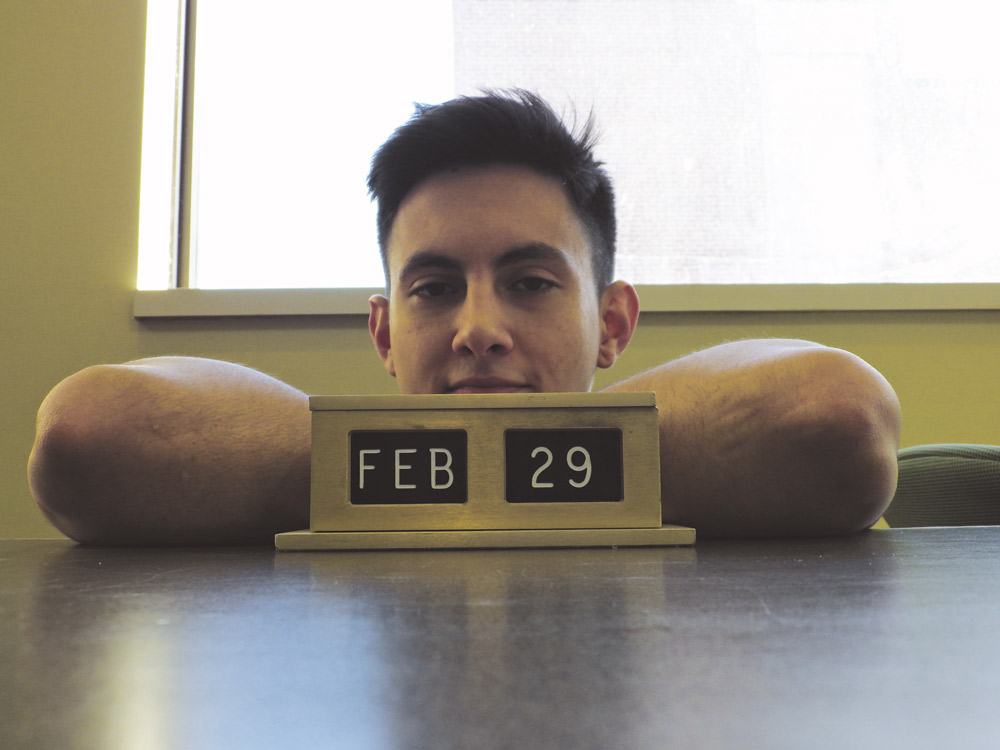
Diego Gondim celebrates his Leap Day birthday on March 1 in 365-day years.
Diego Gondim, a senior in architecture, is turning six on Monday.
No, he isn’t a child; Gondim was born on Leap Day, the date occurring every four years to balance the calendar with Earth’s orbit around the Sun. Leap years have given an extra day to their year for centuries, leaving some people with ties to Feb. 29 waiting a while for their true birthday or anniversary.
In 365-day years, Gondim celebrates on March 1, the day his parents selected as his birthday when he was born in Brazil in 1992.
“In Brazil, you cannot register someone [who] is born on the 29th so the doctors give … the parents the option to register on the 28th or March 1,” Gondim said. “So my ID shows March 1, my passport shows March 1, but I’m actually born Feb. 29.”
Gondim will celebrate his birthday on the actual anniversary Monday, coming only quadrennially. But March 1 isn’t out of the question.
“I have an excuse to tell my friends to go out with me two days in a row,” he said. “Feb. 29 I can go out with them and then March 1 is again my birthday so I have two opportunities to hang out with them.”
Grant Gunderson, a junior zoology major, turns 5 Monday, but he typically celebrates “on a very small scale” on Feb. 28 on non-leap years.
“I am sure as a child when (my parents) asked me, I was particularly impatient to wait, and it maintains the spirt of a February birthday this way,” Gunderson said of his choice of birthday.
As a child, Gunderson said his parents tried to make his true birthdays memorable with trips to Disney World in Orlando at age 12 and a week in Arizona for spring break at age 16.
Unlike Gondim, Gunderson’s legal documents give Feb. 29 as his birthday.
“Although for deadlines like my 18th and 21st birthdays and all the qualifications and legal rights that come with those ages, it requires the date to be March 1 while still listing my true date of birth as the 29th,” he said.
NDSU has 13 students with Feb. 29 birthdays enrolled for the spring 2016 semester, registration & records found. Gondim and Gunderson each know two other leaplings and enjoy their dates of birth.
“I can always make the joke that I can’t grow a beard because I haven’t reached puberty yet,” Gondim said. “I’m only six.”
Leap year
The introduction of the calendar as we know it came in 1582 by Pope Gregory XIII. An extra day was added to February to balance this calendar with the orbit of the earth around the sun.
Earth takes 365 days, 48 minutes and 37 seconds to complete its solar orbit. Leap years balance the near-six extra hours left off the calendar in 365-day years.
Despite 16th century papal astronomers’ estimates, the leap year system is still off by 26 second. By 4909, the Gregorian calendar will be one day ahead of the solar year.
Feb. 29 is not a bank holiday.
Leap second
Leap years are not the only jump in time the Earth makes.
A leap second occurred right before 7 p.m. June 30, 2015. This 61st second is added to Coordinated Universal Time to balance atomic clocks with the Earth’s rotation.
Leap seconds have occurred since 1972 when UTC was 10 seconds behind atomic time, the world’s most accurate timepiece as it measures atom vibrations. Twenty-six leap seconds have occurred since 1972.
Leap seconds occur on June 30 and Dec. 31 at irregular intervals. The last three leap seconds were in 2015, 2012 and 2008, respectively.
